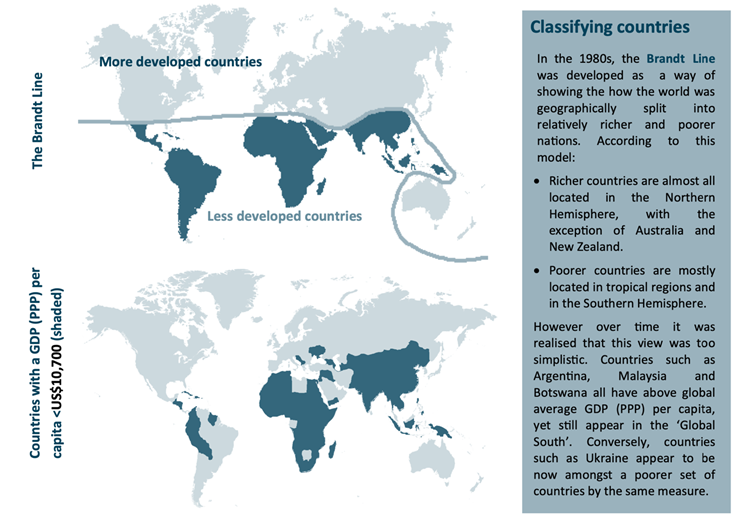Description

Copyright infringement not intended
Context:
- The Vice President of India called for fully exploring the complementarities and opportunities in economic ties with African nations to bring about quicker and sustainable mutual progress.
- He said that the principles of global “South-South cooperation” guided India’s warm and friendly relations with all African countries.
- He added that as India emerges as a key driver in global governance and global growth, African nations will continue to play a prominent role as India’s trusted partners and stakeholders in its prosperity.
- He was addressing the gathering at the Universite Cheikh Anta Diop in Dakar, Senegal – one of the largest Universities in West Africa – on the topic ‘Tiranga and Teranga - 60 years of diplomatic relations between India and Senegal’.
Global North and Global South:
- The concept of Global North and Global South (or North–South divide in a global context) is used to describe a grouping of countries along socio-economic and political characteristics.
- The Global South is a term often used to identify the regions of Latin America, Asia, Africa, and Oceania. It is one of a family of terms, including "Third World" and "Periphery", that denote regions outside Europe and North America, mostly (though not all) low-income and often politically or culturally marginalized countries on one side of the so-called divide, the other side being the countries of the Global North (often equated with developed countries).
- As such, the term does not inherently refer to a geographical south; for example, most of the Global South is geographically within the Northern Hemisphere.
- The term as used by governmental and developmental organizations was first introduced as a more open and value-free alternative to "Third World" and similarly potentially "valuing" terms like developing countries. Countries of the Global South have been described as newly industrialized or in the process of industrializing, and are frequently current or former subjects of colonialism.

Copyright infringement not intended
What is South-South Cooperation?
- South-South cooperation refers to the technical cooperation among developing countries in the Global South.
- It is a tool used by the states, international organizations, academics, civil society and the private sector to collaborate and share knowledge, skills and successful initiatives in specific areas such as agricultural development, human rights, urbanization, health, climate change etc.
- What is now known as South-South cooperation, derives from the adoption of the Buenos Aires Plan of Action for Promoting and Implementing Technical Cooperation among Developing Countries (BAPA) by 138 UN Member States in Argentina, on September 18, 1978.
- The plan established a scheme of collaboration among least developed countries, mostly located in the south of the planet.
- It also established for the first time a framework for this type of cooperation, and incorporated in its practice the basic principles of relations between sovereign States: respect for sovereignty, non-interference in internal affairs and equality of rights, among others.
- The BAPA defined as well a series of new and concrete recommendations aimed at establishing legal frameworks and financing mechanisms at the national, regional, interregional and global levels.
- Technical cooperation was defined in Buenos Aires as “an instrument capable of promoting the exchange of successful experiences among countries that share similar historical realities and similar challenges”.
What about North-South cooperation and Triangular cooperation?
- Although most of the high income countries are indeed located in the northern hemisphere, it should be noted that the division is not totally faithful to the actual geographical division.
- A country is defined as North or South not by location, but depending on certain economic factors and the quality of life of its population.
- North-South cooperation, which is the most traditional type of cooperation, occurs when a developed country supports economically or with another kind of resources a less favored one, for example, with financial aid during a natural disaster or a humanitarian crisis.
- Triangular cooperation, as the name implies, involves three actors, two from the South and one from the North. The latter, which can also be an international organization, provides the financial resources so that the countries of the South can exchange technical assistance on a specific topic.
- For example, in what is considered a successful experience, Japan International Cooperation Agency (JICA) made it possible financially for demining Cambodian experts to travel to Colombia and exchange their knowledge and experience in that field. Both Cambodia and Colombia had a major issue with anti personnel-mines in different moments of their history.
What is the importance of South-South cooperation?
- Innovative forms of knowledge exchange, technology transfer, emergency response and recovery of livelihoods led by the South are transforming lives
- Together with political dialogue and financial cooperation, South-South cooperation has promoted a large number of knowledge and expertise exchanges through programs, projects and initiatives that have helped solve specific problems in the countries of the Global South.
https://www.pib.gov.in/PressReleasePage.aspx?PRID=1831114
1.png)













